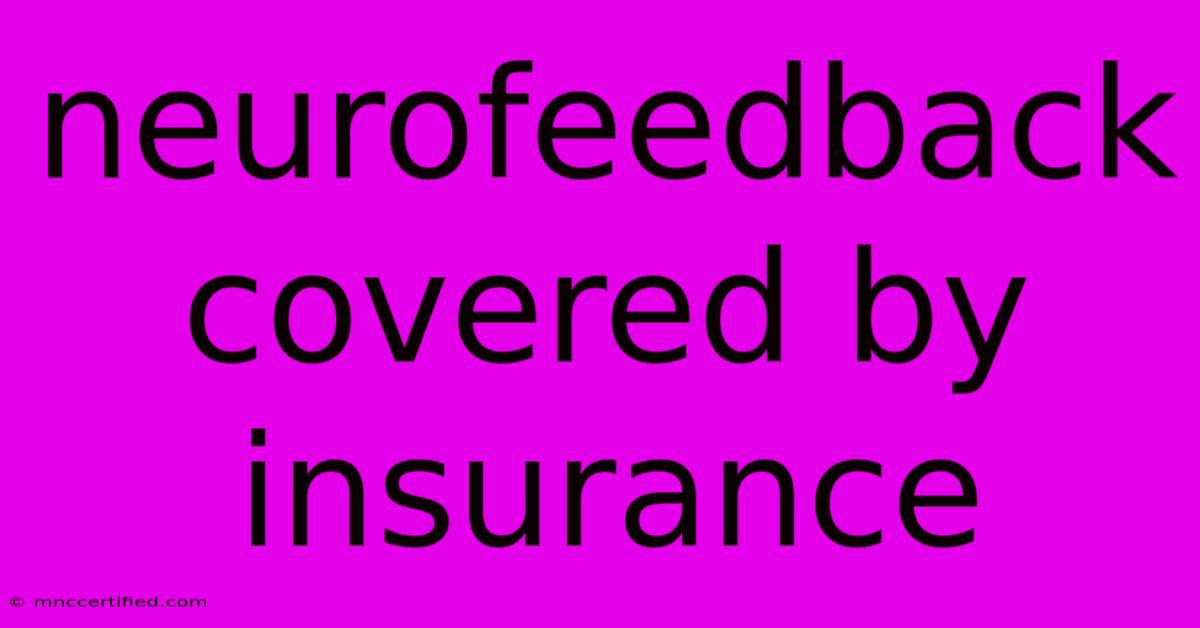Neurofeedback Covered By Insurance

Table of Contents
Neurofeedback Covered by Insurance: A Comprehensive Guide
Neurofeedback, a type of biofeedback therapy that trains your brainwaves to improve mental health, is increasingly sought after for various conditions. However, a common question arises: Is neurofeedback covered by insurance? The answer, unfortunately, isn't a simple yes or no. Coverage depends heavily on several factors, and navigating the insurance landscape can be challenging. This comprehensive guide will help you understand the complexities and increase your chances of securing coverage.
Factors Affecting Insurance Coverage for Neurofeedback
Several factors determine whether your insurance provider will cover neurofeedback therapy. These include:
-
Your Insurance Provider: Different insurance companies have varying policies regarding alternative therapies like neurofeedback. Some may cover it explicitly, while others may not. Check your policy's specific benefits and exclusions carefully. Contacting your insurance company directly is crucial.
-
Your Diagnosis: Insurance companies are more likely to cover neurofeedback if it's prescribed for a specific, diagnosable condition. Conditions like ADHD, anxiety disorders, depression, traumatic brain injury (TBI), and PTSD are more frequently considered for coverage. Having a clear diagnosis from a qualified healthcare professional significantly strengthens your case.
-
The Provider's Credentials: Insurance companies often require the neurofeedback provider to be licensed and certified. Ensure your therapist is qualified and meets your insurance provider's requirements. Look for board-certified professionals and those with experience in working with insurance claims.
-
Medical Necessity: This is a key factor. Your provider needs to justify the medical necessity of neurofeedback for your specific condition. They'll likely need to provide documentation supporting the need for this treatment and its potential benefits compared to other therapies. This often involves detailed progress reports.
-
Type of Neurofeedback: Different types of neurofeedback exist, and coverage may vary depending on the specific method used. Discuss the options with your provider to determine which is most appropriate for you and potentially covered by insurance.
How to Increase Your Chances of Neurofeedback Insurance Coverage
Here are practical steps to maximize your chances of successful insurance coverage:
-
Obtain a Diagnosis: A proper diagnosis from a physician or psychiatrist is essential. This forms the basis for your provider to justify the medical necessity of neurofeedback.
-
Choose a Qualified Provider: Opt for a provider experienced in working with insurance companies. Ask about their success rate with insurance claims and their process for submitting documentation.
-
Pre-Authorization: Before starting treatment, contact your insurance company to pre-authorize the neurofeedback sessions. This involves obtaining written approval for coverage in advance. This step is critical and can prevent unexpected out-of-pocket costs.
-
Thorough Documentation: Your provider needs to meticulously document your progress and the effectiveness of the neurofeedback therapy. This documentation will support the claims submitted to your insurance company.
-
Appeal Denied Claims: If your claim is denied, don't give up. Carefully review the denial reason and work with your provider to prepare a strong appeal. Often, providing additional documentation or a detailed explanation can overturn a denial.
Alternatives if Neurofeedback Isn't Covered
If your insurance doesn't cover neurofeedback, consider these options:
- Payment Plans: Many neurofeedback providers offer flexible payment plans to make treatment more affordable.
- Health Savings Accounts (HSAs) and Flexible Spending Accounts (FSAs): These accounts can help offset the cost of out-of-pocket medical expenses.
- Crowdfunding: Platforms like GoFundMe can help you raise funds for your treatment.
Conclusion
While securing insurance coverage for neurofeedback requires effort and persistence, it's definitely achievable. By understanding the factors influencing coverage and taking proactive steps, you can significantly improve your chances of receiving financial assistance for this potentially life-changing therapy. Remember to always communicate clearly with your insurance provider and your neurofeedback therapist to ensure a smooth process. Your mental health is worth the effort!

Thank you for visiting our website wich cover about Neurofeedback Covered By Insurance. We hope the information provided has been useful to you. Feel free to contact us if you have any questions or need further assistance. See you next time and dont miss to bookmark.
Featured Posts
-
Breast Milk Storage Bags Insurance
Nov 16, 2024
-
What Is A Hard Market In Insurance
Nov 16, 2024
-
Scotland Vs Croatia Free Online Game
Nov 16, 2024
-
Cost Of Crna Malpractice Insurance
Nov 16, 2024
-
Magnum Insurance Kankakee Illinois
Nov 16, 2024